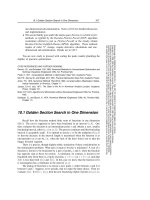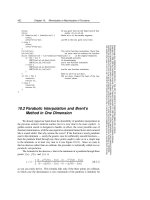Lập Trình C# all Chap "NUMERICAL RECIPES IN C" part 26 ppsx
Bạn đang xem bản rút gọn của tài liệu. Xem và tải ngay bản đầy đủ của tài liệu tại đây (133.82 KB, 4 trang )
252
Chapter 6. Special Functions
Sample page from NUMERICAL RECIPES IN C: THE ART OF SCIENTIFIC COMPUTING (ISBN 0-521-43108-5)
Copyright (C) 1988-1992 by Cambridge University Press.Programs Copyright (C) 1988-1992 by Numerical Recipes Software.
Permission is granted for internet users to make one paper copy for their own personal use. Further reproduction, or any copying of machine-
readable files (including this one) to any servercomputer, is strictly prohibited. To order Numerical Recipes books,diskettes, or CDROMs
visit website or call 1-800-872-7423 (North America only),or send email to (outside North America).
CITED REFERENCES AND FURTHER READING:
Barnett, A.R., Feng, D.H., Steed, J.W., and Goldfarb, L.J.B. 1974,
Computer Physics Commu-
nications
, vol. 8, pp. 377–395. [1]
Temme, N.M. 1976,
Journal of Computational Physics
, vol. 21, pp. 343–350 [2]; 1975,
op. cit.
,
vol. 19, pp. 324–337. [3]
Thompson, I.J., and Barnett, A.R. 1987,
Computer Physics Communications
, vol. 47, pp. 245–
257. [4]
Barnett, A.R. 1981,
Computer Physics Communications
, vol. 21, pp. 297–314.
Thompson, I.J., and Barnett, A.R. 1986,
Journal of Computational Physics
, vol. 64, pp. 490–509.
Abramowitz, M., and Stegun, I.A. 1964,
Handbook of Mathematical Functions
, Applied Mathe-
matics Series, Volume 55 (Washington: National Bureau of Standards; reprinted 1968 by
Dover Publications, New York), Chapter 10.
6.8 Spherical Harmonics
Spherical harmonics occur in a large variety of physical problems, for ex-
ample, whenever a wave equation, or Laplace’s equation, is solved by separa-
tion of variables in spherical coordinates. The spherical harmonic Y
lm
(θ, φ),
−l ≤ m ≤ l, is a function of the two coordinates θ, φ on the surface of a sphere.
The spherical harmonics are orthogonal for different l and m, and they are
normalized so that their integrated square over the sphere is unity:
2π
0
dφ
1
−1
d(cos θ)Y
l
m
*(θ, φ)Y
lm
(θ, φ)=δ
l
l
δ
m
m
(6.8.1)
Here asterisk denotes complex conjugation.
Mathematically, the spherical harmonics are related to associated Legendre
polynomials by the equation
Y
lm
(θ, φ)=
2l+1
4π
(l−m)!
(l + m)!
P
m
l
(cos θ)e
imφ
(6.8.2)
By using the relation
Y
l,− m
(θ, φ)=(−1)
m
Y
lm
*(θ, φ)(6.8.3)
we can always relate a spherical harmonic to an associated Legendre polynomial
with m ≥ 0. With x ≡ cos θ, these are defined in terms of the ordinary Legendre
polynomials (cf. §4.5 and §5.5) by
P
m
l
(x)=(−1)
m
(1 − x
2
)
m/2
d
m
dx
m
P
l
(x)(6.8.4)
6.8 Spherical Harmonics
253
Sample page from NUMERICAL RECIPES IN C: THE ART OF SCIENTIFIC COMPUTING (ISBN 0-521-43108-5)
Copyright (C) 1988-1992 by Cambridge University Press.Programs Copyright (C) 1988-1992 by Numerical Recipes Software.
Permission is granted for internet users to make one paper copy for their own personal use. Further reproduction, or any copying of machine-
readable files (including this one) to any servercomputer, is strictly prohibited. To order Numerical Recipes books,diskettes, or CDROMs
visit website or call 1-800-872-7423 (North America only),or send email to (outside North America).
The first few associated Legendre polynomials, and their corresponding nor-
malized spherical harmonics, are
P
0
0
(x)= 1 Y
00
=
1
4π
P
1
1
(x)= −(1 −x
2
)
1/2
Y
11
= −
3
8π
sin θe
iφ
P
0
1
(x)= xY
10
=
3
4π
cos θ
P
2
2
(x)= 3(1−x
2
) Y
22
=
1
4
15
2π
sin
2
θe
2iφ
P
1
2
(x)=−3(1−x
2
)
1/2
xY
21
= −
15
8π
sin θ cos θe
iφ
P
0
2
(x)=
1
2
(3x
2
− 1) Y
20
=
5
4π
(
3
2
cos
2
θ −
1
2
)
(6.8.5)
There are many bad ways to evaluate associated Legendre polynomials numer-
ically. For example, there are explicit expressions, such as
P
m
l
(x)=
(−1)
m
(l + m)!
2
m
m!(l −m)!
(1 − x
2
)
m/2
1 −
(l − m)(m + l +1)
1!(m +1)
1−x
2
+
(l−m)(l − m − 1)(m + l +1)(m+l+2)
2!(m +1)(m+2)
1−x
2
2
−···
(6.8.6)
where the polynomial continues up through the term in (1 − x)
l−m
.(See
[1]
for
this and related formulas.) This is not a satisfactory method because evaluation
of the polynomial involves delicate cancellations between successive terms, which
alternate in sign. For large l, the individual terms in the polynomial become very
much larger than their sum, and all accuracy is lost.
In practice, (6.8.6) can be used only in single precision (32-bit) for l up
to 6 or 8, and in double precision (64-bit) for l up to 15 or 18, depending on
the precision required for the answer. A more robust computational procedure is
therefore desirable, as follows:
The associated Legendre functions satisfy numerous recurrence relations, tab-
ulated in
[1-2]
. These are recurrences on l alone, on m alone, and on both l and
m simultaneously. Most of the recurrences involving m are unstable, and so
dangerous for numerical work. The following recurrence on l is, however, stable
(compare 5.5.1):
(l − m)P
m
l
= x(2l − 1)P
m
l−1
−(l + m − 1)P
m
l−2
(6.8.7)
It is useful because there is a closed-form expression for the starting value,
P
m
m
=(−1)
m
(2m − 1)!!(1 −x
2
)
m/2
(6.8.8)
(The notation n!! denotes the product of all odd integers less than or equal to n.)
Using (6.8.7) with l = m +1, and setting P
m
m−1
=0,wefind
P
m
m+1
= x(2m +1)P
m
m
(6.8.9)
Equations (6.8.8) and (6.8.9) provide the two starting values required for (6.8.7)
for general l.
The function that implements this is
254
Chapter 6. Special Functions
Sample page from NUMERICAL RECIPES IN C: THE ART OF SCIENTIFIC COMPUTING (ISBN 0-521-43108-5)
Copyright (C) 1988-1992 by Cambridge University Press.Programs Copyright (C) 1988-1992 by Numerical Recipes Software.
Permission is granted for internet users to make one paper copy for their own personal use. Further reproduction, or any copying of machine-
readable files (including this one) to any servercomputer, is strictly prohibited. To order Numerical Recipes books,diskettes, or CDROMs
visit website or call 1-800-872-7423 (North America only),or send email to (outside North America).
#include <math.h>
float plgndr(int l, int m, float x)
Computes the associated Legendre polynomial P
m
l
(x).Heremand l are integers satisfying
0 ≤ m ≤ l, while x lies in the range −1 ≤ x ≤ 1.
{
void nrerror(char error_text[]);
float fact,pll,pmm,pmmp1,somx2;
int i,ll;
if(m<0||m>l||fabs(x) > 1.0)
nrerror("Bad arguments in routine plgndr");
pmm=1.0; Compute P
m
m
.
if (m > 0) {
somx2=sqrt((1.0-x)*(1.0+x));
fact=1.0;
for (i=1;i<=m;i++) {
pmm *= -fact*somx2;
fact += 2.0;
}
}
if (l == m)
return pmm;
else { Compute P
m
m+1
.
pmmp1=x*(2*m+1)*pmm;
if (l == (m+1))
return pmmp1;
else { Compute P
m
l
, l>m+1.
for (ll=m+2;ll<=l;ll++) {
pll=(x*(2*ll-1)*pmmp1-(ll+m-1)*pmm)/(ll-m);
pmm=pmmp1;
pmmp1=pll;
}
return pll;
}
}
}
CITED REFERENCES AND FURTHER READING:
Magnus, W., and Oberhettinger, F. 1949,
Formulas and Theorems for the Functions of Mathe-
matical Physics
(New York: Chelsea), pp. 54ff. [1]
Abramowitz, M., and Stegun, I.A. 1964,
Handbook of Mathematical Functions
, Applied Mathe-
matics Series, Volume 55 (Washington: National Bureau of Standards; reprinted 1968 by
Dover Publications, New York), Chapter 8. [2]
6.9 Fresnel Integrals, Cosine and Sine Integrals
255
Sample page from NUMERICAL RECIPES IN C: THE ART OF SCIENTIFIC COMPUTING (ISBN 0-521-43108-5)
Copyright (C) 1988-1992 by Cambridge University Press.Programs Copyright (C) 1988-1992 by Numerical Recipes Software.
Permission is granted for internet users to make one paper copy for their own personal use. Further reproduction, or any copying of machine-
readable files (including this one) to any servercomputer, is strictly prohibited. To order Numerical Recipes books,diskettes, or CDROMs
visit website or call 1-800-872-7423 (North America only),or send email to (outside North America).
6.9 Fresnel Integrals, Cosine and Sine Integrals
Fresnel Integrals
The two Fresnel integrals are defined by
C(x)=
x
0
cos
π
2
t
2
dt, S(x)=
x
0
sin
π
2
t
2
dt (6.9.1)
The most convenient way of evaluating these functions to arbitrary precision is
to use power series for small x and a continued fraction for large x. The series are
C(x)=x−
π
2
2
x
5
5·2!
+
π
2
4
x
9
9 · 4!
−···
S(x)=
π
2
x
3
3·1!
−
π
2
3
x
7
7 · 3!
+
π
2
5
x
11
11 · 5!
−···
(6.9.2)
There is a complex continued fraction that yields both S(x) and C(x) si-
multaneously:
C(x)+iS(x)=
1+i
2
erf z, z =
√
π
2
(1 − i)x (6.9.3)
where
e
z
2
erfc z =
1
√
π
1
z +
1/2
z +
1
z +
3/2
z +
2
z +
···
=
2z
√
π
1
2z
2
+1−
1·2
2z
2
+5−
3·4
2z
2
+9−
···
(6.9.4)
In the last line we have converted the “standard” form of the continued fraction to
its “even” form (see §5.2), which converges twice as fast. We must be careful not
to evaluate the alternating series (6.9.2) at too large a value of x; inspection of the
terms shows that x =1.5is a good point to switch over to the continued fraction.
Note that for large x
C(x) ∼
1
2
+
1
πx
sin
π
2
x
2
,S(x)∼
1
2
−
1
πx
cos
π
2
x
2
(6.9.5)
Thus the precision of the routine frenel may be limited by the precision of the
library routines for sine and cosine for large x.









